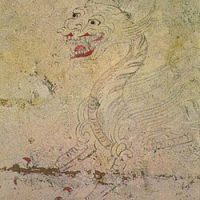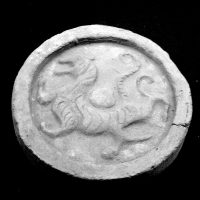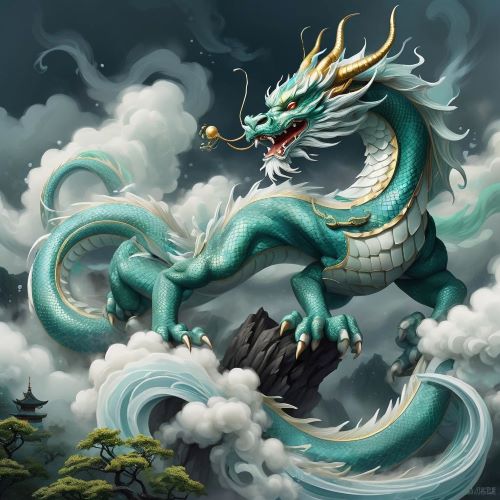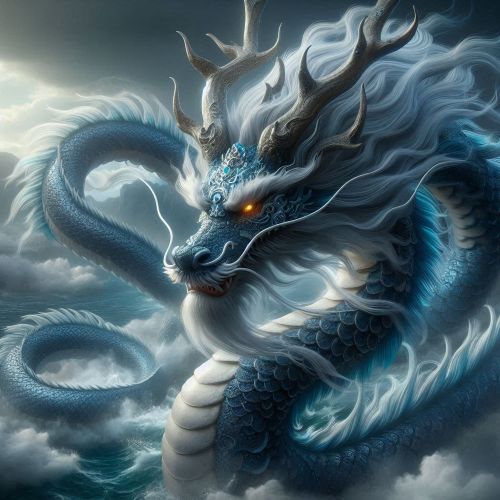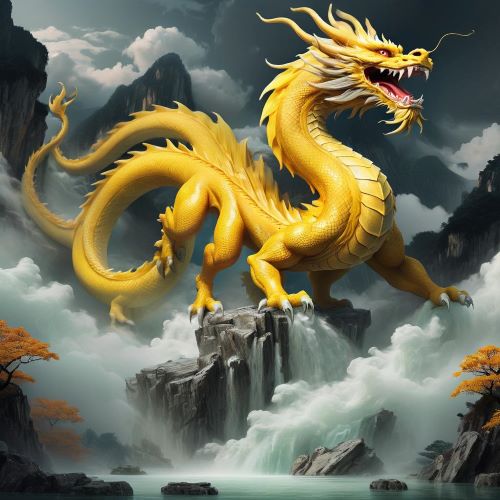Baihu : The White Tiger Guardian of the West
Listen
At a glance
| Description | |
|---|---|
| Origin | Chinese Mythology |
| Classification | Animals |
| Family Members | Huanglong (Parent) |
| Region | Chinese |
| Associated With | Protection |
Baihu
Introduction
Baihu, the White Tiger of Chinese mythology, is one of the most revered celestial creatures among the Four Symbols (Si Xiang) — the guardians that represent the cardinal directions and seasons. As the protector of the West and the embodiment of autumn and the metal element, Baihu signifies valor, purity, and divine justice. Within the ancient Chinese worldview, Baihu’s role transcends that of a mythical animal; it is a cosmic force that ensures balance between life and death, order and chaos. Across millennia, Baihu has inspired spiritual traditions, imperial symbolism, martial rituals, and modern popular culture, where it continues to represent integrity, courage, and protection.
Physical Traits
Baihu is described as a magnificent white tiger with a commanding presence and ethereal glow. Its coat, as white as freshly fallen snow, sometimes shimmers with silver or blue undertones, representing its connection to metal and the moon. The creature’s muscular frame, broad shoulders, and intense gaze convey both grace and ferocity. In many artistic depictions, Baihu’s body is adorned with swirling patterns symbolizing the movement of wind and the shifting energies of autumn. Legends say that its roar echoes like thunder, a sound powerful enough to disperse evil spirits and herald the end of a cosmic cycle. The rarity of white tigers in nature has amplified Baihu’s mythic status, marking it as a divine being born from purity, endurance, and transformation.
Family
Unlike creatures born from human or divine parentage, Baihu’s existence stems from cosmic order rather than lineage. It is one of the Four Celestial Guardians — alongside Qinglong, the Azure Dragon of the East; Zhuque, the Vermilion Bird of the South; and Xuanwu, the Black Tortoise of the North. Together, these beings form the pillars of heaven and regulate the balance of natural and spiritual forces. Baihu’s dominion lies in the western skies, associated with the element of metal and the principles of righteousness and retribution. Some Daoist traditions describe a fifth central being, Huanglong, the Yellow Dragon, as the unifying power that harmonizes these four guardians. While Baihu has no offspring or consort, it remains a divine counterpart to Qinglong — the two representing the eternal dance between yin and yang, autumn and spring, death and renewal.
Other names
Across East Asia, Baihu is recognized under various names that reflect local adaptations and linguistic traditions. In Japan, it is known as Byakko, revered as a symbol of valor and the divine protector of the West. In Korea, the same entity is called Baekho, often depicted in military emblems and folklore as a guardian of moral integrity. In Vietnamese mythology, Baihu takes the form of Bạch Hổ, embodying protection, justice, and strength. Within China itself, alternative titles such as Jin Hu (Metal Tiger) and Xi Fang Shou Hu (Western Guardian) emphasize its elemental power and celestial role. Each version maintains the core symbolism of the White Tiger — a force of balance, endurance, and righteousness that stands watch over humanity.
Powers and Abilities
Baihu’s powers are vast, extending from the physical to the spiritual realms. As the celestial guardian of the West, Baihu is said to repel demons and malign energies that threaten harmony. It commands the element of metal, symbolizing resilience, precision, and moral clarity. These traits made Baihu a patron deity for soldiers and generals who sought divine protection and success in battle. In Daoist metaphysics, Baihu governs the yin energies associated with twilight, endings, and transformation — complementing the yang of the Azure Dragon, which represents dawn and beginnings.
The White Tiger is also believed to control the forces of autumn, overseeing the harvest and the natural decline that precedes renewal. In ancient warfare, warriors painted Baihu’s likeness on shields and banners to invoke its power before battle. Its roar was said to drive away evil spirits and ill fortune, while its presence ensured justice against wrongdoing. As a celestial enforcer, Baihu embodies the law of retribution — punishing the wicked and safeguarding those who uphold virtue.
Modern Day Influence
Baihu’s symbolism continues to thrive in the modern world, resonating deeply across spiritual, artistic, and cultural domains. In Chinese martial arts, Baihu represents discipline, precision, and inner strength; many schools and military divisions use its image to invoke courage and loyalty. Temples dedicated to Baihu can still be found throughout China and East Asia, where devotees offer incense for protection and success.
In feng shui, Baihu occupies the right-hand side of a sacred layout, balancing the Azure Dragon on the left. This positioning reflects cosmic harmony and is believed to protect households from misfortune. Architects and artisans often carve Baihu motifs into gates, walls, and tombs to guard against negative energies.
The White Tiger’s presence is equally strong in literature, films, and digital entertainment. From historical dramas and epic novels to anime, video games, and graphic novels, Baihu is often portrayed as a noble guardian or formidable spirit beast. In contemporary Chinese art and design, its sleek white form is reimagined as a symbol of justice and purity — a visual representation of both ancient wisdom and modern heroism. Baihu’s influence even extends to political and corporate imagery, where it represents integrity, strategic strength, and reliability.
Related Images
Source
Eberhard, W. (2003). A Dictionary of Chinese Symbols: Hidden Symbols in Chinese Life and Thought. Routledge.
Schafer, E. H. (1963). The Golden Peaches of Samarkand: A Study of T’ang Exotics. University of California Press.
Yang, L., & An, D. (2005). Handbook of Chinese Mythology. Oxford University Press.
Chinese Mythology. (2023). Baihu (White Tiger). Retrieved from https://www.chinamyth.com/baihu-white-tiger/
Travel China Guide. (2024). Chinese Zodiac and Mythology: Baihu. Retrieved from https://www.travelchinaguide.com/intro/astrology/baihu/
Wu, K. C. (1982). The Chinese Heritage. Crown Publishers.
Smith, R. J. (2009). Cosmos and Society in Ancient China. Stanford University Press.
Williams, C. A. S. (2006). Outlines of Chinese Symbolism and Art Motives. Dover Publications.
Wikipedia contributors. (n.d.). White Tiger (mythology). Wikipedia. Retrieved from https://en.wikipedia.org/wiki/White_Tiger_%28mythology%29
Yang, L. (2005). Handbook of Chinese Mythology. Oxford University Press.
Wu, K. C. (1982). The Chinese Heritage. Crown Publishers.
Schafer, E. H. (1963). The Golden Peaches of Samarkand: A Study of T’ang Exotics. University of California Press.
Little, S., & Eichman, S. (2000). Taoism and the Arts of China. Art Institute of Chicago.
Rawson, P. (1992). Sacred Tibet: The Path of the Mystic. Thames & Hudson.
Frequently Asked Questions
Who is Baihu in Chinese mythology?
Baihu, also known as the White Tiger, is one of the Four Symbols of Chinese cosmology and represents the western direction, autumn, and the element of metal.
What does Baihu symbolize?
Baihu symbolizes courage, strength, and righteousness. It is also seen as a guardian against evil forces and a protector of the righteous.
How is Baihu depicted in Chinese art?
Baihu is often shown as a majestic white tiger with shimmering fur and fierce eyes, embodying both power and divine authority.
What is Baihu’s role among the Four Symbols?
As one of the Four Symbols, Baihu rules over the West and embodies the energy of autumn, complementing Azure Dragon (East), Vermilion Bird (South), and Black Tortoise (North).
Is Baihu worshipped or celebrated today?
Yes, Baihu remains a respected figure in Taoist traditions, martial arts symbolism, and cultural festivals across China and East Asia as a timeless emblem of protection and valor.



